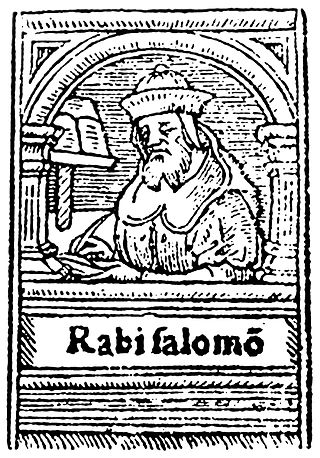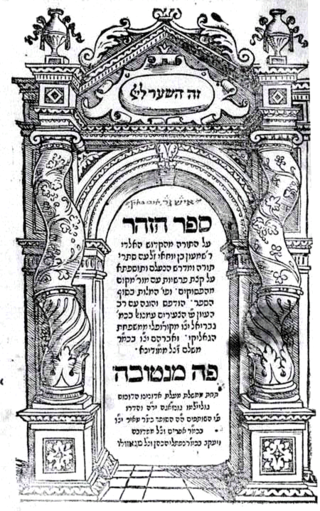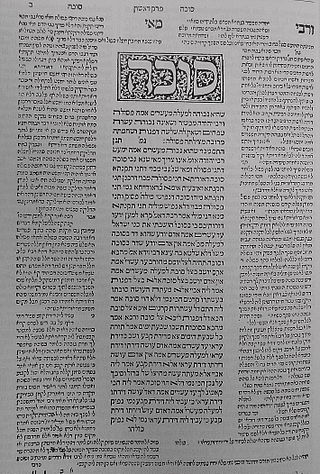Related Research Articles

The Mishnah or the Mishna is the first major written collection of the Jewish oral traditions that are known as the Oral Torah. It is also the first major work of rabbinic literature. The Mishnah was redacted by Judah ha-Nasi probably in Beit Shearim or Sepphoris between the ending of the second century and the beginning of the 3rd century CE in a time when the persecution of Jews and the passage of time raised the possibility that the details of the oral traditions of the Pharisees from the Second Temple period would be forgotten.

Shlomo Yitzchaki, commonly known by the acronym Rashi, was a French rabbi who authored comprehensive commentaries on the Talmud and Hebrew Bible.

The Talmud is the central text of Rabbinic Judaism and the primary source of Jewish religious law (halakha) and Jewish theology. Until the advent of modernity, in nearly all Jewish communities, the Talmud was the centerpiece of Jewish cultural life and was foundational to "all Jewish thought and aspirations", serving also as "the guide for the daily life" of Jews.

The Zohar is a foundational work of Kabbalistic literature. It is a group of books including commentary on the mystical aspects of the Torah and scriptural interpretations as well as material on mysticism, mythical cosmogony, and mystical psychology. The Zohar contains discussions of the nature of God, the origin and structure of the universe, the nature of souls, redemption, the relationship of ego to darkness and "true self" to "the light of God".
Year 1475 (MCDLXXV) was a common year starting on Sunday of the Julian calendar.
This article is a list of the literary events and publications in the 15th century.

The Tosafot,Tosafos or Tosfot are medieval commentaries on the Talmud. They take the form of critical and explanatory glosses, printed, in almost all Talmud editions, on the outer margin and opposite Rashi's notes.

Obadiah ben Abraham of Bertinoro, commonly known as "The Bartenura", was a 15th-century Italian rabbi best known for his popular commentary on the Mishnah. In his later years, he rejuvenated the Jewish community of Jerusalem and became recognised as the spiritual leader of the Jews of his generation.
Jacob ben Meir, best known as Rabbeinu Tam, was one of the most renowned Ashkenazi Jewish rabbis and leading French Tosafists, a leading halakhic authority in his generation, and a grandson of Rashi. Known as "Rabbeinu", he acquired the Hebrew suffix "Tam" meaning straightforward; it was originally used in the Book of Genesis to describe his biblical namesake, Jacob.

Daniel Bomberg was one of the most important early printers of Hebrew books. A Christian Hebraist who employed rabbis, scholars and apostates in his Venice publishing house, Bomberg printed the first Mikraot Gdolot and the first complete Babylonian and Jerusalem Talmuds, based on the layout pioneered by the Soncino family printers, with the commentaries of Rashi, and of the Tosfot in the margins. The editions set standards that are still in use today, in particular the pagination of the Babylonian Talmud. His publishing house printed about 200 Hebrew books, including Siddurim, responsa, codes of law, works of philosophy and ethics and commentaries. He was the first Hebrew printer in Venice and the first non-Jewish printer of Hebrew books.
The Rashi script or Sephardic script is a typeface for the Hebrew alphabet based on 15th-century Sephardic semi-cursive handwriting. It is named for the rabbinic commentator Rashi, whose works are customarily printed in the typeface. It was taken as a model by early Hebrew typographers such as Abraham Garton, the Soncino family and Daniel Bomberg in their editions of commented texts.

Chumash is a Torah in printed and book bound form as opposed to a Sefer Torah, which is a scroll.
Soncino Press is a Jewish publishing company based in the United Kingdom that has published a variety of books of Jewish interest, most notably English translations and commentaries to the Talmud and Hebrew Bible. The Soncino Hebrew Bible and Talmud translations and commentaries were widely used in both Orthodox and Conservative synagogues until the advent of other translations beginning in the 1990s.
Jewish commentaries on the Bible are biblical commentaries of the Hebrew Bible from a Jewish perspective. Translations into Aramaic and English, and some universally accepted Jewish commentaries with notes on their method of approach and also some modern translations into English with notes are listed.
Jewish printers were quick to take advantages of the printing press in publishing the Hebrew Bible. While for synagogue services written scrolls were used, the printing press was very soon called into service to provide copies of the Hebrew Bible for private use. All the editions published before the Complutensian Polyglot were edited by Jews; but afterwards, and because of the increased interest excited in the Bible by the Reformation, the work was taken up by Christian scholars and printers; and the editions published by Jews after this time were largely influenced by these Christian publications. It is not possible in the present article to enumerate all the editions, whole or partial, of the Hebrew text. This account is devoted mainly to the incunabula.
The Hebrew incunabula are a group of Jewish religious texts printed in Hebrew in the 15th century.

Sifrei Kodesh, commonly referred to as sefarim, or in its singular form, sefer, are books of Jewish religious literature and are viewed by religious Jews as sacred. These are generally works of Torah literature, i.e. Tanakh and all works that expound on it, including the Mishnah, Midrash, Talmud, and all works of halakha, Musar, Hasidism, Kabbalah, or machshavah. Historically, sifrei kodesh were generally written in Hebrew with some in Judeo-Aramaic or Arabic, although in recent years, thousands of titles in other languages, most notably English, were published. An alternative spelling for 'sefarim' is seforim.

The history of the Jews in Calabria reaches back over two millennia. Calabria is at the very south of the Italian peninsula, to which it is connected by the Monte Pollino massif, while on the east, south and west it is surrounded by the Ionian and Tyrrhenian seas. Jews have had a presence in Calabria for at least 1600 years and possibly as much as 2300 years. Calabrian Jews have had notable influence on many areas of Jewish life and culture. The Jews of Calabria are virtually identical to the neighbouring Jews of Sicily but are considered separate. However, the Jews of Calabria and the Jews of Apulia are historically the same community, only today are considered separate. Occasionally, there is confusion with the southern Jewish community in Calabria and the northern Jewish community in Reggio Emilia. Both communities have always been entirely separate.
The Valmadonna Trust Library was a collection of 13,000 printed books and manuscripts printed in Hebrew or in Hebrew script. It was sold by the Trustees in January 2017 to the National Library of Israel (NLI). It is named after Valmadonna, a small town near Alessandria in north-west Italy with longstanding connections to the Lunzer family. The collection encompasses works from throughout the world, particularly Italy, "the cradle of Hebrew printing", and covers over a millennium; many items in the collection are rare or unique, and many date back to the earliest Hebrew printings. Before it was acquired by the NLI, Arthur Kiron, curator of Judaica collections at the University of Pennsylvania, said, "I don't know any other collection quite like it in private hands. It even rivals some of the great institutional collections in the world."
Solomon Sirilio (1485–1554), the son of Joseph Sirilio, was a Spanish rabbi and author of one of the first commentaries written about the Jerusalem Talmud.
References
- ↑ Adri K. Offenberg, 'The Chronology of Hebrew Printing at Mantua in the Fifteenth Century: A Re-examination', The Library, sixth series, 16 (4) (1994), p. 299.
- ↑ www.jerusalembooks.com
- ↑ jewishencyclopedia.com Archived June 5, 2007, at the Wayback Machine
- ↑ "www.library.upenn.edu". Archived from the original on 2011-06-08. Retrieved 2009-05-27.